Blog 03/01/2024 - Totenkopf - "The Death Head"
MHT’s EXPLORATION OF THE TOTENKOPF – THE GERMAN DEATH HEAD
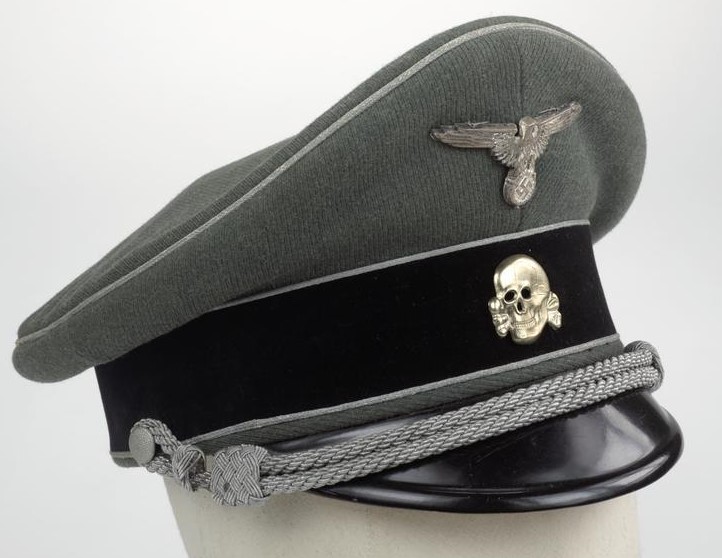
While writing the Blog on the movie “Napoleon” I also watched “Waterloo” that related that The Duchess of Richmond's Ball was held on 15 June 1815, the night before the Battle of Quatre Bras versus Napoleon’s reconstituted Grand Armée.
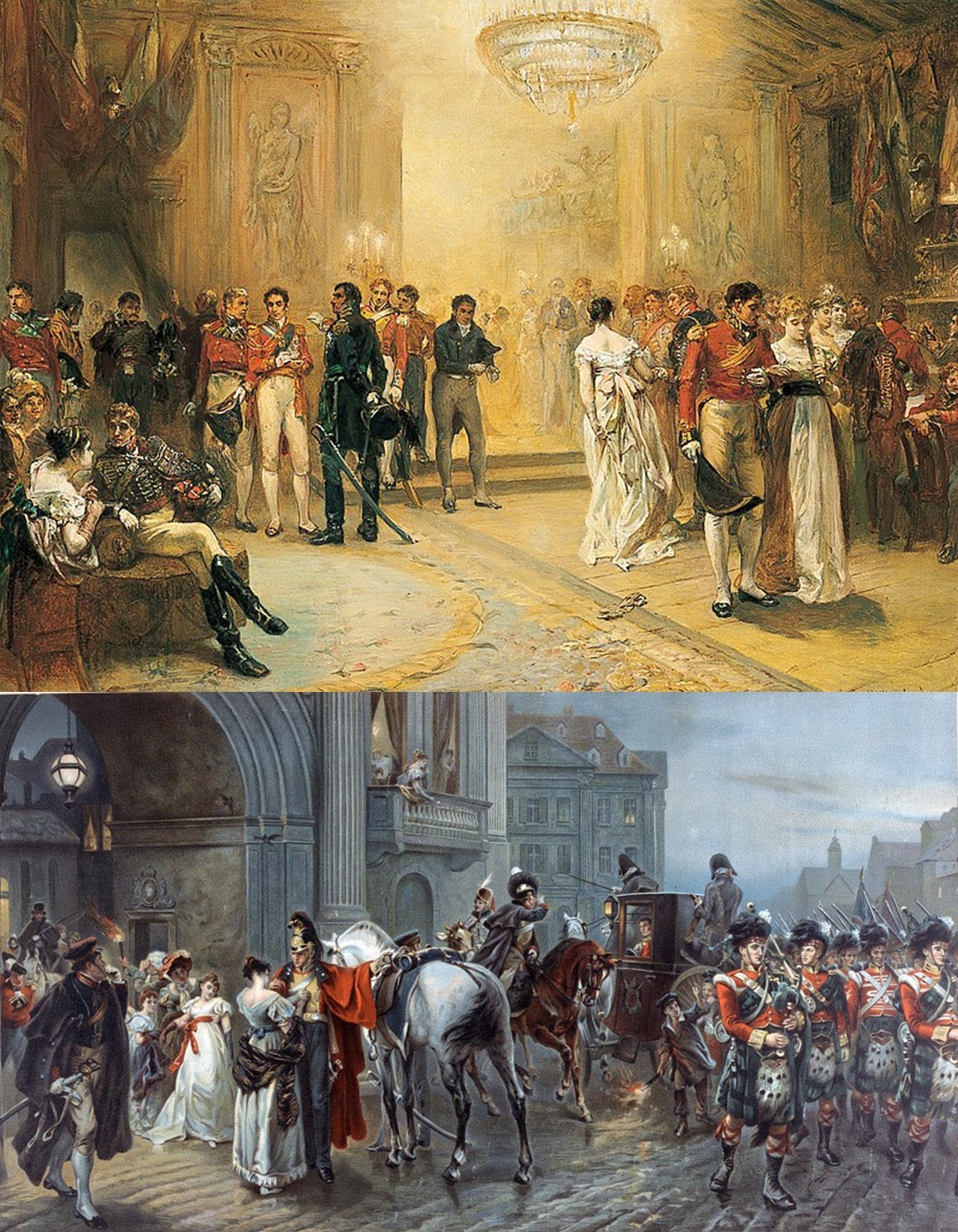
One historian described it as "the most famous ball in history." The ball was certainly a brilliant affair," attended "with the exception of three generals, every officer high in the Duke of Wellington's army was there to be seen." Shortly, after the arrival of the Duke of Wellington, a messenger arrived with word of Napoleon's unexpected advance on the nearby crossroads of Quatre Bras. This forced him to order his officers to leave to join their regiments. Some of the officers would soon die in battle & the poignancy of the drama has provided an enduring theme for artists, novelists & poets.

The most famous painting is “The Black Brunswicker” (1860), by John Everett Millais inspired in part by the exploits of the Brunswicker Hussars (light cavalry) & in part by the contrasts of the resplendent uniform’s black broadcloth & the gown’s pearl-white satin in a moment of tender wartime farewell. The artwork took an estimated three months to paint, and it was greatly admired at the time. Author Charles Dickens' daughter Kate was used as a model for the woman seen in the painting. What fascinated me was the military cover (headgear) the Hussar officer is holding known as a “Busby” that had a large skull & crossbones on it called a “Totenkopf” by the Prussians.

A busby is the English name for the Hungarian prémes csákó ("fur shako") a military head-dress made of fur, originally worn by Hungarian light cavalry hussars. In its original Hungarian form the busby was a cylindrical fur cap, having a bag of colored cloth hanging from the top. The end of this bag was filled with sand attached to the right shoulder as a defense against saber cuts.
Totenkopf Hussars
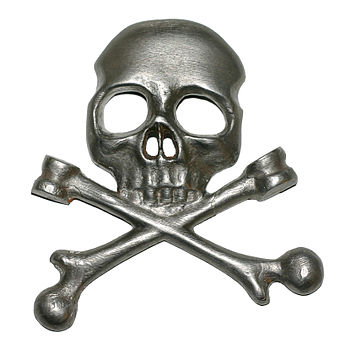
Use of the Totenkopf as a military emblem began under Frederick the Great, who formed a regiment of Hussar cavalry in the Prussian Army. These were the first known military units to openly use a skull motif were the Prussian hussar regiments 1st Leib-Husaren-Regiment No. 1 and 2nd Leib-Husaren-Regiment No. 2 , both of which were raised on August 9, 1741.
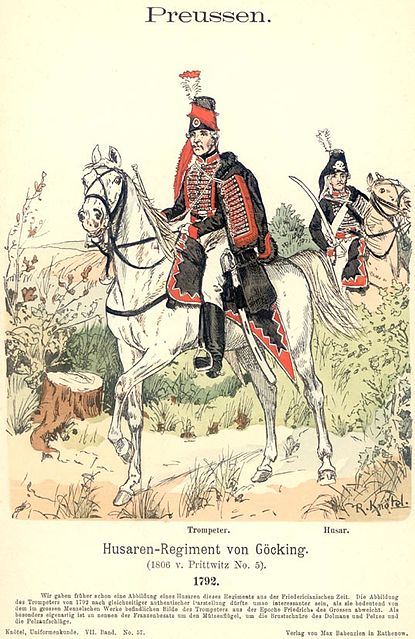
It adopted a black uniform with a Totenkopf emblazoned on the front of its mirlitons (also called flügelmütze or flügelkappe, a tall conical hat worn by hussars, light cavalrymen, & light infantrymen in the period 1750–1800) that they wore during the War of Austrian Succession & in the Seven Years' War. The Totenkopf remained a part of the uniform when the regiment was reformed in 1808. The skull continued to be used by the Prussian & Brunswick armed forces until 1918. Some of the stormtroopers that led the last German offensives on the Western Front in 1918 used skull badges.
Walk the Ground in Waterloo with MHT: https://miltours.com/index.php?route=product/product&path=17&product_id=82
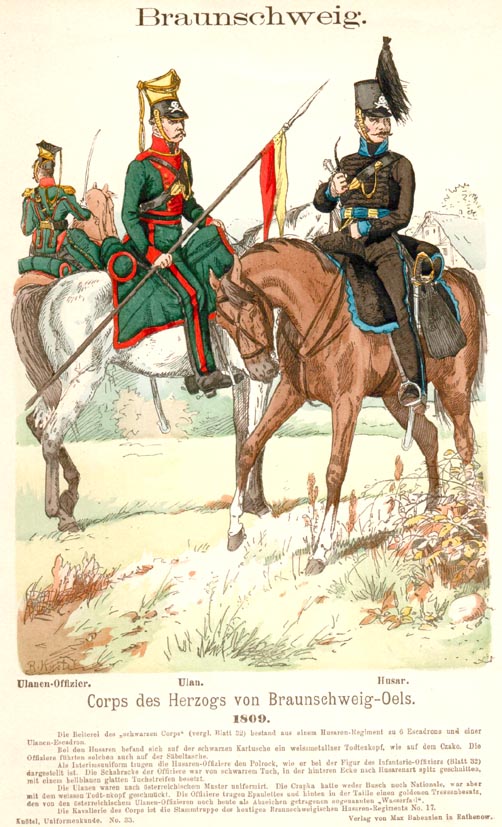
The original Brunswick Hussars were formed by "Black Duke" Friedrich Wilhelm von Braunschweig to fight against Napoleon & wore the distinctive busby. It served with the English in Spain & while still under English command it moved to Sicily in the Mediterranean. The "Black Duke" set up a new hussar regiment in Wolfenbüttel in the spring of 1814. This one also served with the English in 1814 & 1815 & took part in the Battle of Quatre-Bras on June 16, 1815 and in the Battle of Waterloo on June 18, 1815. The young hussar officer in Millais’ painting was serving in this reconstituted second regiment. Walk the Ground with MHT: https://miltours.com/index.php?route=product/product&path=17&product_id=176
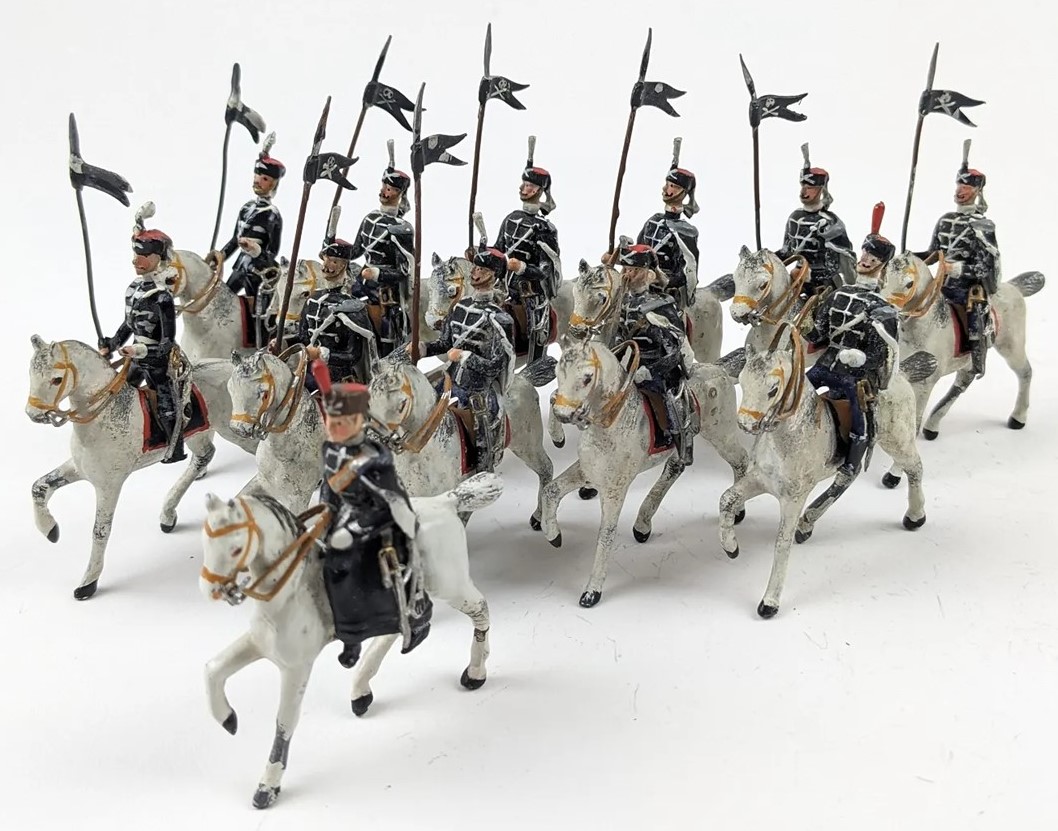
The Husaren Pelzmütze (fur cap) made famous by the German Hussars spread to many more nations light cavalry units prior to WWI. Some German Hussars continued with the Death’s Head Busby featuring the Totenkopf. The hats were typically made from animal furs to provide warmth in colder climates, and with the addition of the Totenkopf, makes for an intimidating piece of headgear. Everyone will recognize the symbol as the one that was adopted by Hitler’s Schutzstaffel in the Second World War.
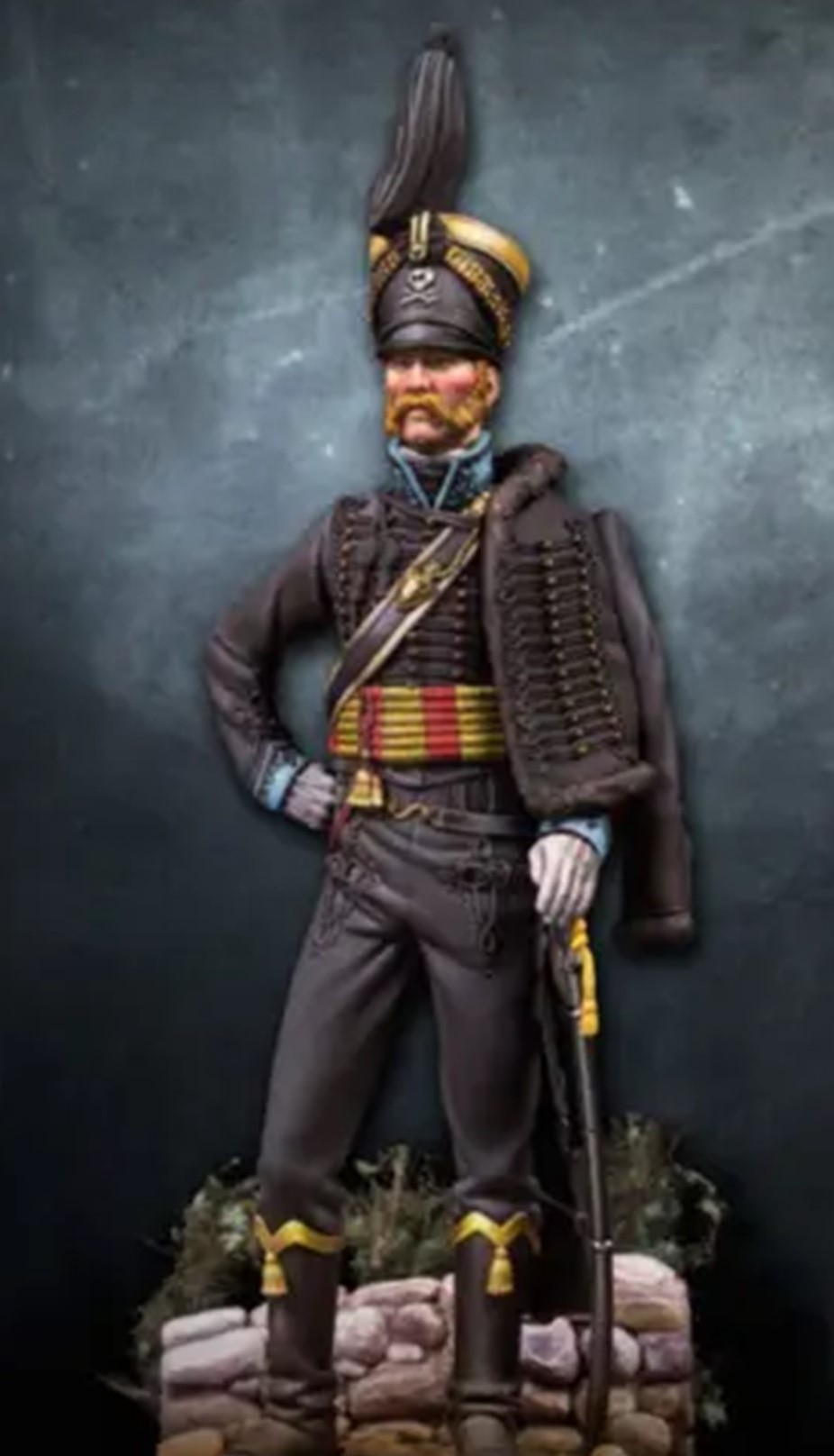
Because of the skull worn on their busby caps, Totenkopfhusaren was a popular name for the 1st & 2nd Life Hussar Regiments in Danzig. After the Braunschweig (Brunswick) Hussar Regiment No. 17 received permission to “re-apply” the skull symbol in 1883 in memory of their nicknames the Black Horde, Black Legion or Black Squad. Since the 18th century, the skull symbol has signaled that they would neither take nor give quarter (The phrase to 'Give no quarter' means to show no mercy for a vanquished opponent. 'Quarter' had long been used to mean 'exemption from being immediately put to death granted to a vanquished opponent by the victor in battle.)
Here are some examples:
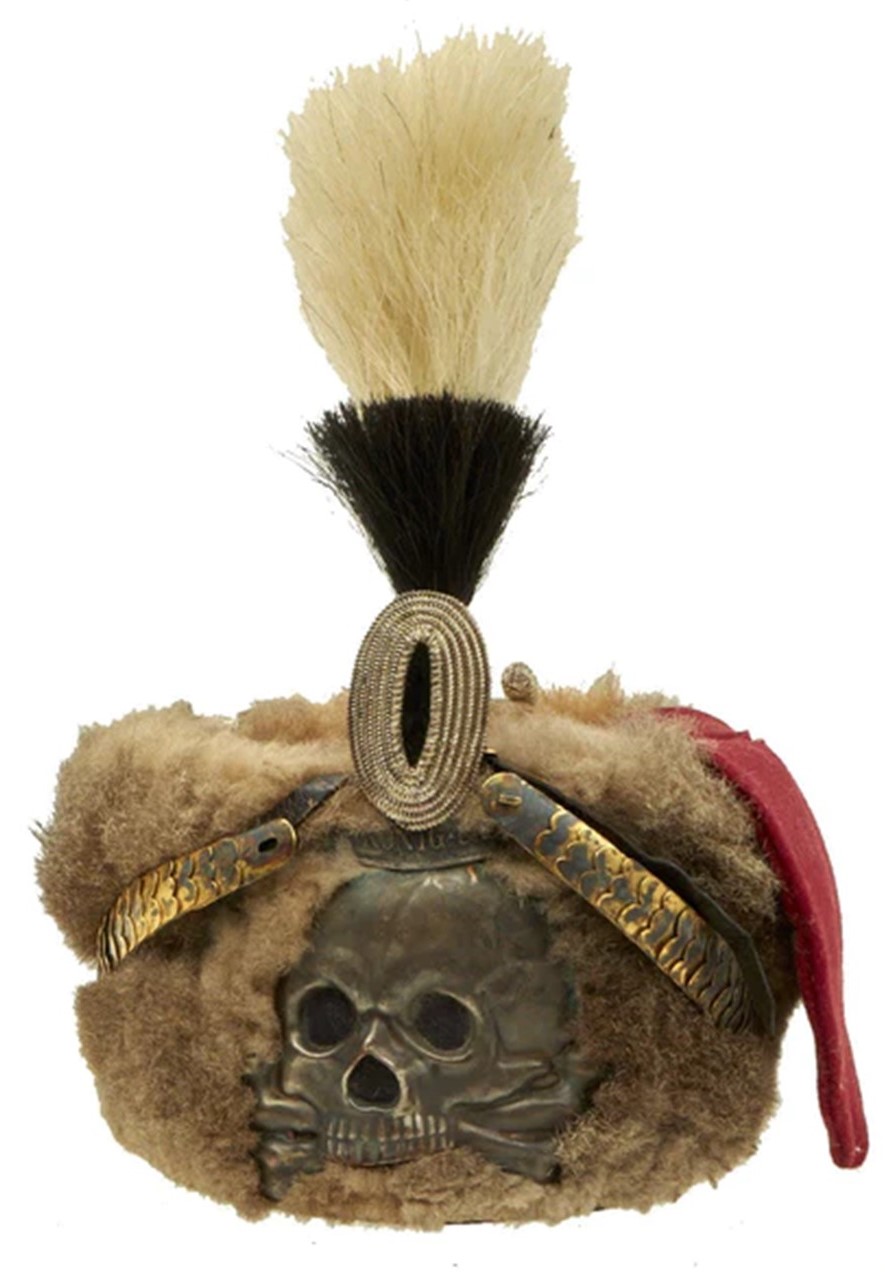
1) Here is a busby for officers in the 1st & 2nd Life Hussar Regiment “Queen Victoria von Prussia” No. 2. The fur covering was upgraded, originally being otter fur in the 19th century, and moving to Opossum fur in the early 20th century, when this example probably dates from. A This is truly a dramatic cap, & epitomizes the typical ornate style of 19th century European Hussar headwear.
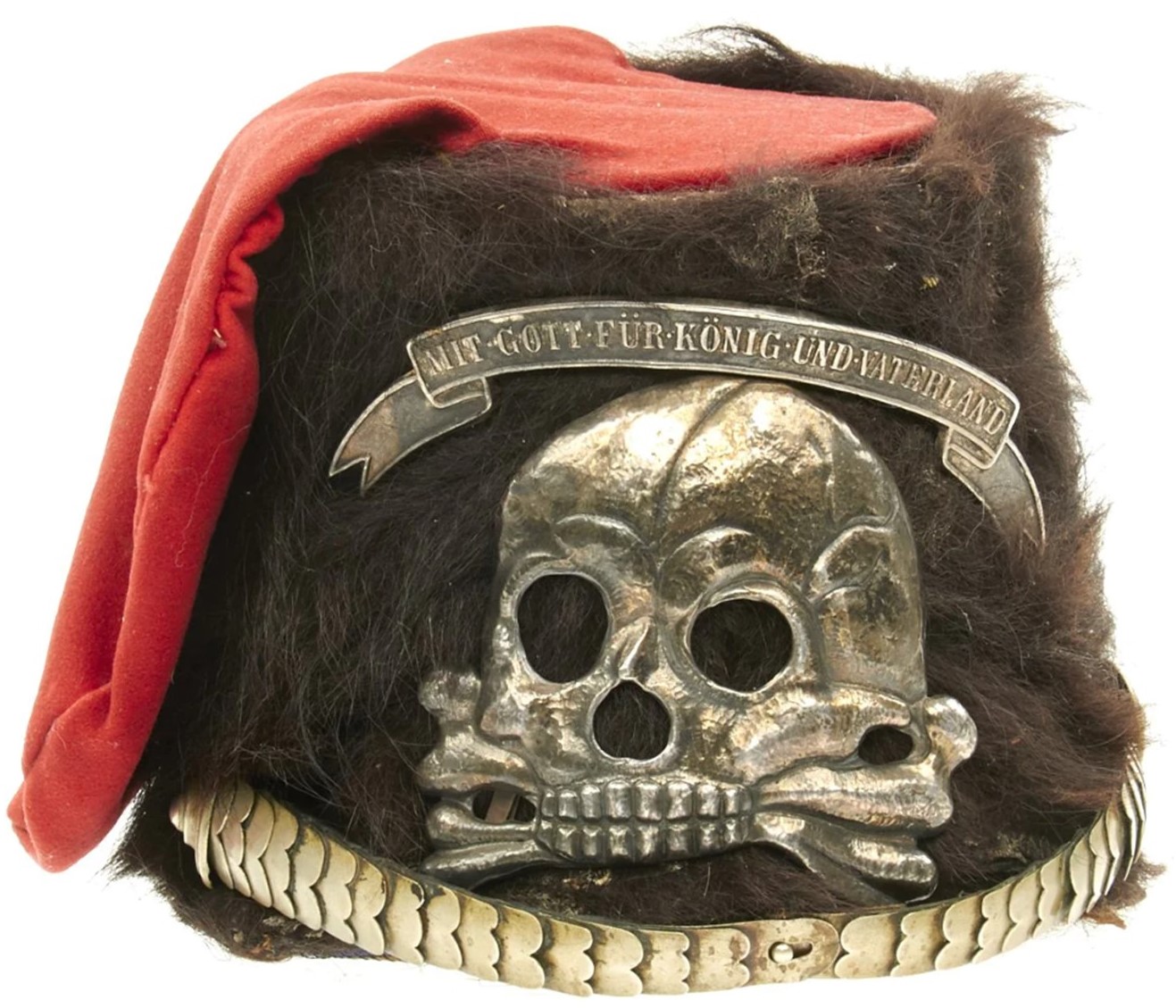
2) This is the Napoleonic Brunswick Busby that was shorter than the Hungarian mirlitons but still had the red slouch bag for anti-saber protection. It has the massive Death head Totenkopf with the Prussian Motto “MIT GOTT FÜR KÖNIG UND VATERLAND (With God For King & Fatherland)
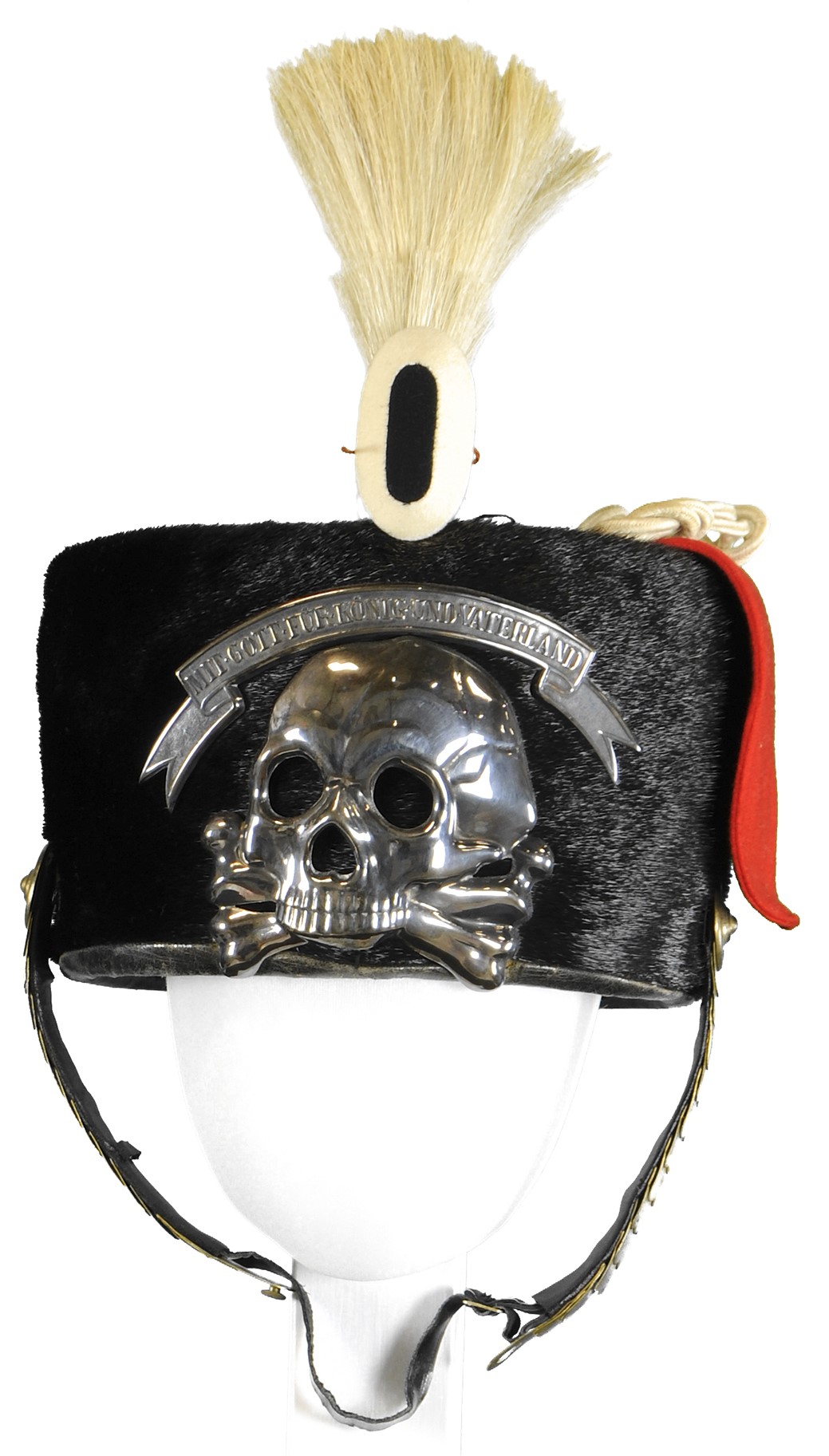
3) Years later, the size & design were scaled down, and they became much more for looks at parades & formal events than for actual protection. The exterior bearskin wrap shows its 100+ year age but still has the the helmet comes with its red slouch bag hanging over the right ear. The busby also comes complete with its correct "German Silver" chin scales, only used by Officers. It is still extraordinary that before 1914, Hussars actually wore these into battle but during WWI every soldier had been issued a steel helmet while horses were largely made superfluous with the use of Motor Transport & Trench Warfare with Machine Guns. As in the painting the busby represents the highest form of the "Pomp and Circumstance" of Military uniforms & still conveys a sense of romance & gallantry.
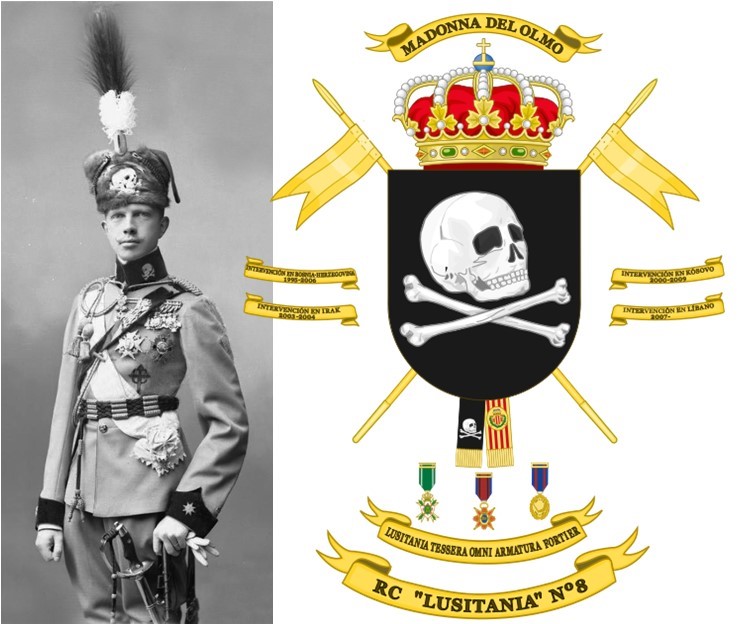
4) Pictured in a Totenkopf Busby is Infante (Prince) Fernando of Spain wearing the uniform of the 8th Light Armored Cavalry Regiment "Lusitania" in 1914. On September 30, 1744 during the Battle of “Madona del Olmo” the “Lusitania” Regiment was honored with an emblem consisting of a skull with two crossbones. The King of Sardinia, Carlos Manuel III, breached the Spanish-French line with his select Croatian Infantry, opening a gap that two Spanish Dragoon regiments, the “Numancia” & “Lusitania,” managed to stop the advance.
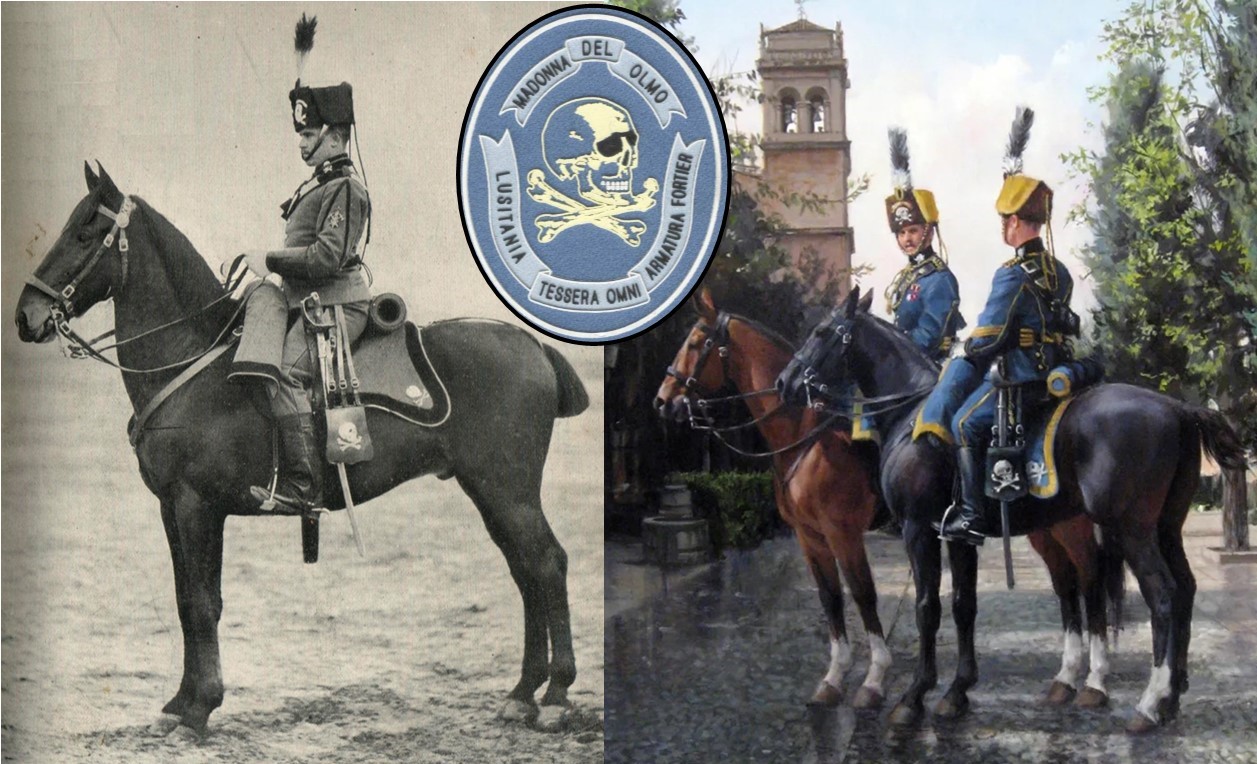
The Lusitania not satisfied with the enemy's retreat continued to counterattack despite their numerical inferiority losing two thirds of their ranks killed in the pursuit. The courageous advance disrupted the plans of the Sardinian King of Sardinia & due to his army’s heavy casualties he was forced to his withdraw that night. The “Lusitania” earned the nickname “Dragons of Death ” & in their memory the Spanish King, Philip V granted the Regiment the privilege of wearing skulls and crossbones on their uniform.
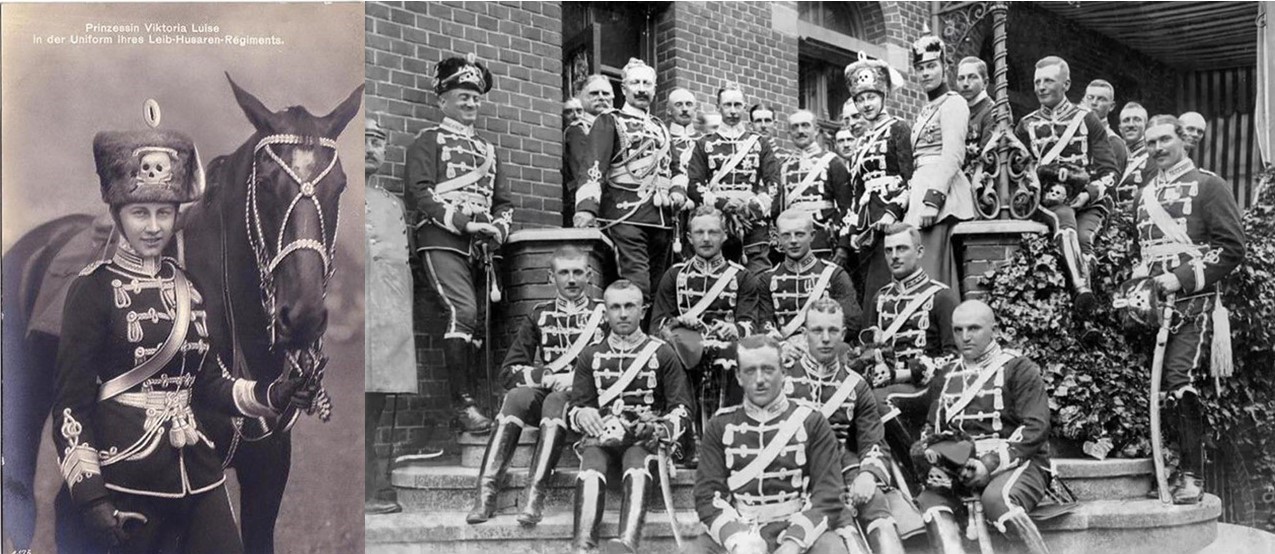
Even Prussian Royals were enamored with the striking uniforms of the Hussars like Princess Viktoria Luise (Victoria Louise), only daughter & the youngest child of Wilhelm II & Augusta Victoria of Schleswig-Holstein. The last German Emperor’s daughter was the honorary Colonel of the Death's Head Hussars Regiment as Duchess of Brunswick & regularly inspected the hussars, complete in her uniform. Through her father, Victoria Louise was a great-granddaughter of Queen Victoria of the United Kingdom.
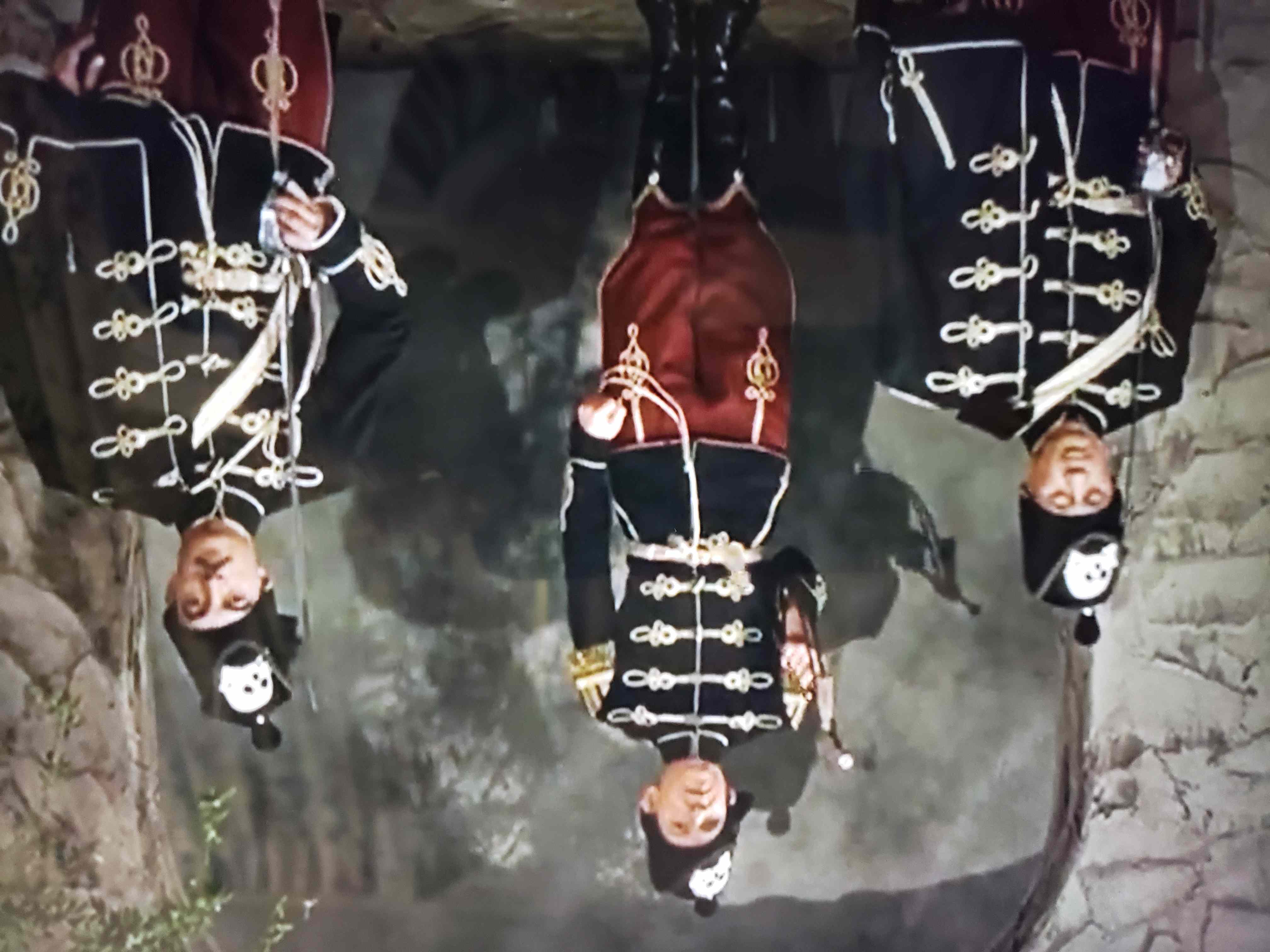
Even the 3 Stooges dipped into Columbia Pictures Studio Wardrobe for the fine uniforms of the “Death Head” Hussars in their second slapstick comic send-up of fascism in 1941 to make maybe their finest short, “I’ll Never Heil Again.” The palace guards are clearly wearing some Totenkopf Hussar uniforms. I love the opening caption, “The characters in this picture are all fictitious. Anyone resembling them is better off dead.” with Moe playing the Dictator (Hitler), Larry as Minister of Propaganda (Goebbels) & Curly as the corpulent Field Marshal (Göring) & even Napoleon makes an appearance.

The skull as an illustration of the phrase "Memento Mori": "Remember that you are mortal!" It dates at least as far back as the early Roman Empire as can be seen in this mosaic decorated with a skull, a plumb line, a wheel and various other elements. The mosaic was found in the excavation of a Pompeii villa in 1874 that was buried in the Mount Vesuvius volcanic eruption in 79 A.D. This mosaic is full of symbolism, the skull recalls the ultimate mortality of man. On the left, t. It all comes down to one sentence: whatever the condition of men (rich or poor), all are mortal. Very often represented in the painting, the motif of the human skull invites a meditation on death. The mosaic also presents the Wheel of "Fortuna" which, when it turns, can make you rich on the left represented by purple clothes in ancient times or poor with rags on the right. Today, it can be seen at the Archaeological Museum of Naples.
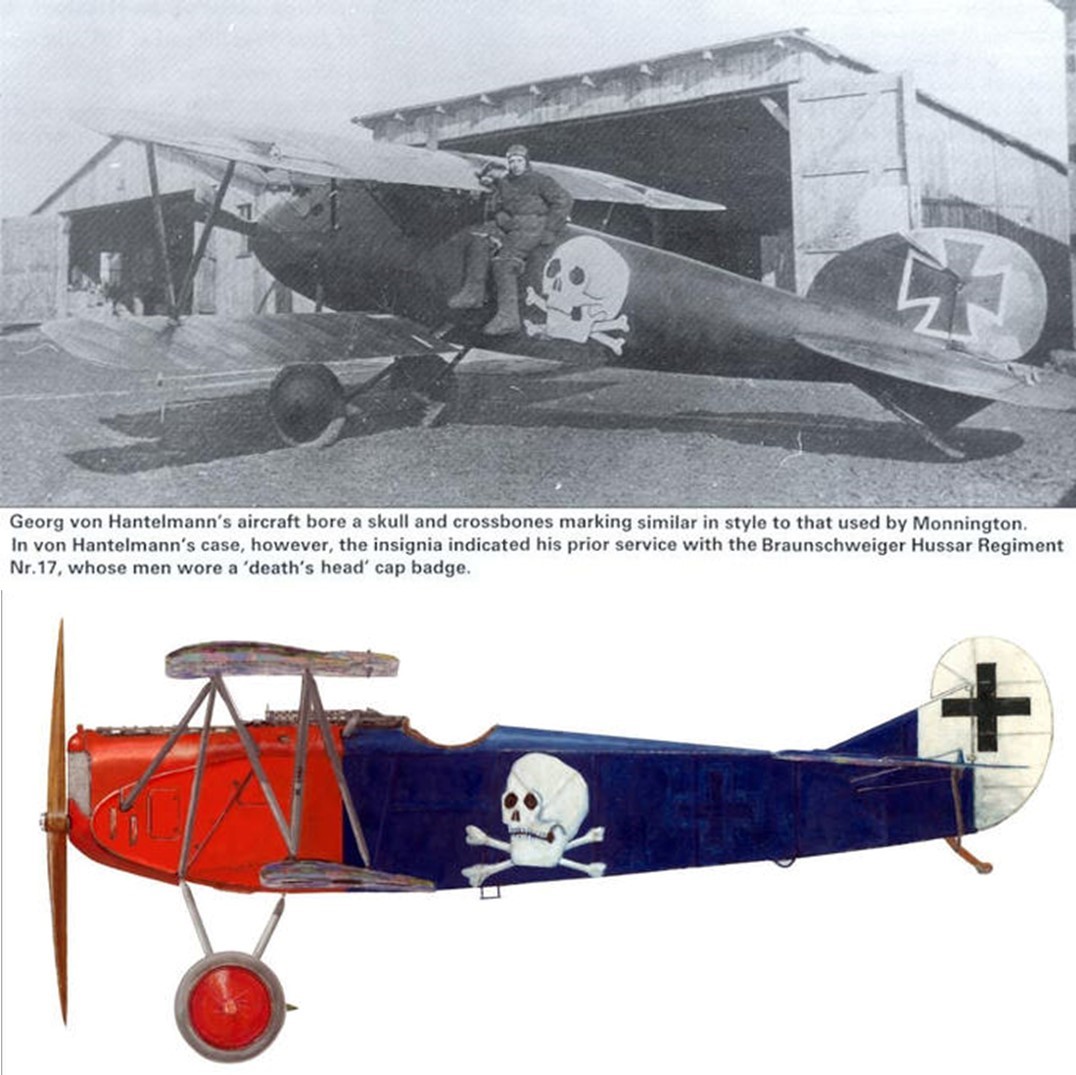
In WWI, the Luftstreitkräfte (Imperial German Air Service) had fighter pilots Georg von Hantelmann & Kurt Adolf Monnington are just two of a number of Central Powers military pilots who used the Totenkopf as their personal aircraft insignia.
Death’s Head Hawkmoth
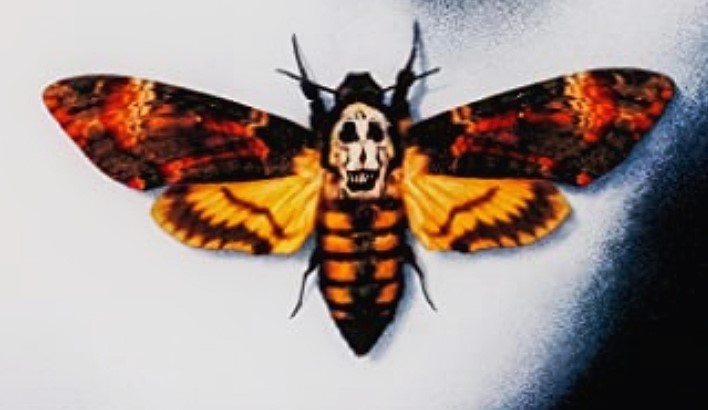
Even the animal kingdom has its Totenkopf as reported in 1875, the death's-head moth, as found in South Africa, is about the size & length of a man's finger, & it has a most perfect death's-head-and-marrowbones painted by Nature with all her beauty on its back. The skull-like pattern has raised fanciful myths of instant death, supernatural folklore & evil have fostered superstitious fears of Acherontia species, particularly the most observed Acherontia Atropos. Even during the mid-19th century, entomologist Edward Newman wrote: "However, let the cause of the noise (a sharp, mouse-like squeaking) be what it may, the effect is to produce the most superstitious feelings among the uneducated, by whom it is always regarded with feelings of awe & terror."
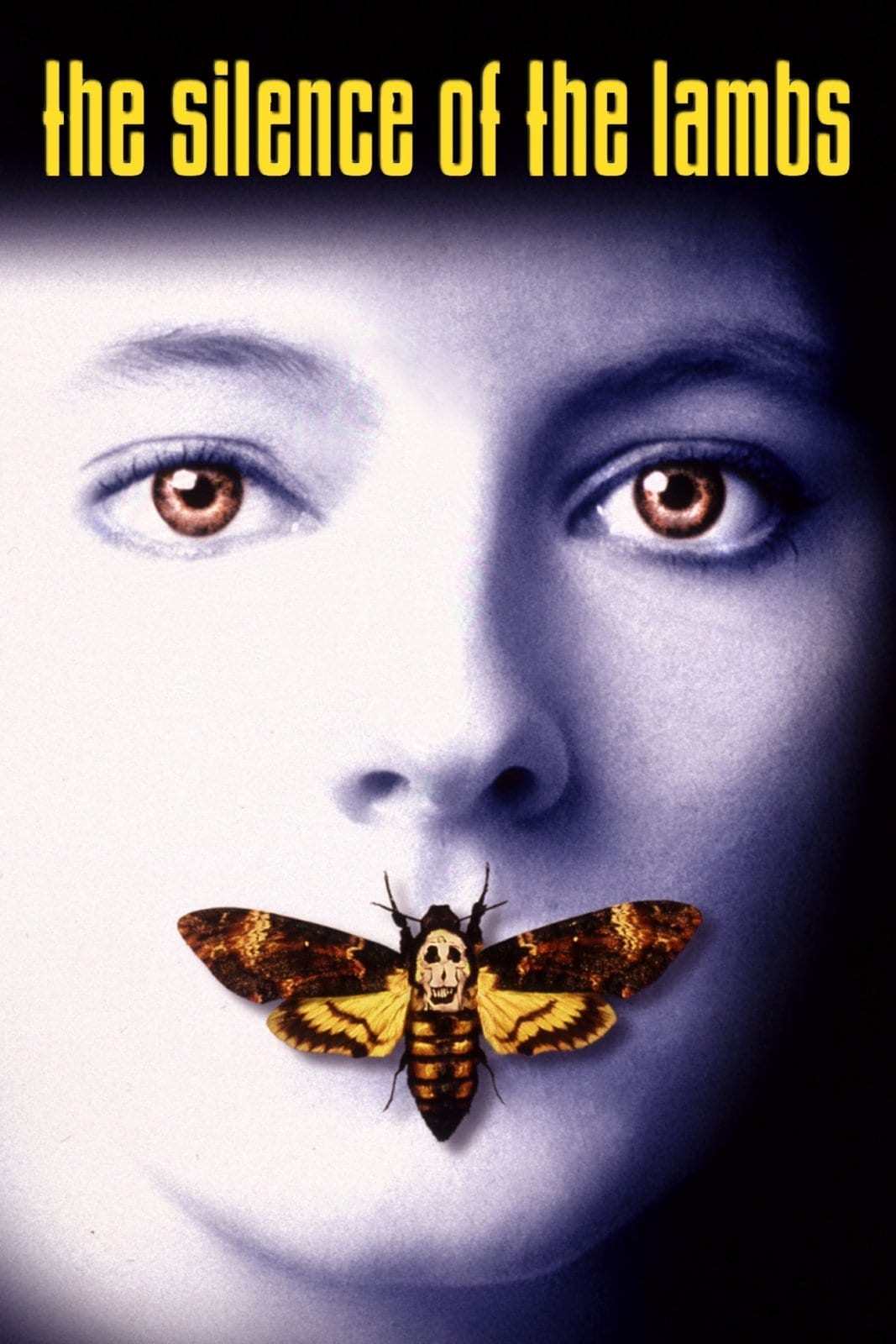
Master of Terror Edgar Allan Poe describes a close encounter with a death's-head sphinx moth in his short story “The Sphinx.” The moth has appeared in films such as “Un Chien Andalou” (1929, by Luis Buñuel & Salvador Dalí) that played before David Bowie’s 1976 “Thin White Duke Tour” & more famously in “The Silence of the Lambs” that proved to be the clue that ended serial killer Buffalo Bills maniacal tailoring of a “girl suit!”
Jolly Roger Flag (clockwise photos from top left):

Oceangoing English Pirates trademark flag contained the skull & crossbones symbol, that had first been recorded on flags from the 17th century. It is believed that the idea was borrowed from the designs on flags used by the Barbary pirates (Ottoman Corsairs in the Mediterranean) that used to operate under a green flag with a skull symbol.
In the Caribbean Sea, some pirate flags were comprised of a white skull ("Death's Head") on a black flag, without cross-bones, as used by Howell Davis, Richard Worley & Stede Bonnet.
Edward “Blackbeard” Teach’s (killed in battle 22 November 1718), was an English pirate who operated around the West Indies & along the eastern coast of the American colonies. His flag features a horned skeleton raising an hourglass "toasting the Devil" in its right hand. In the skeleton's left hand, it held a spear pointing towards a red heart which had three drops of red blood below it, supposedly to signal that no quarter would be given. Teach captured a French slave ship known as La Concorde, renamed her Queen Anne's Revenge, armed her with 40 cannons & a crew of 300 pirates which made him a renowned & feared pirate.
“Teach, Rackham & Bonny” as shown in the Starz TV Series “Black Sails.”
John “Jack” Rackham (hanged 18 November 1720), commonly known as Calico Jack, was an English pirate captain operating in the Bahamas & Cuba during the early 18th century. His nickname was derived from the calico clothing that he wore, while Jack was active during the "Golden Age of Piracy". He is most remembered for having two female crew members: Mary Read and his lover, Anne Bonny. The flag commonly associated with Rackham depicts a white skull above crossed swords on a black background, and Rackham is sometimes credited with inventing this Jolly Roger.
Edward England (died of disease 1721) was an Irish pirate. His flag was the classic Jolly Roger, almost exactly as the one "Black Sam" Bellamy (killed when ship capsized in 1717) used with a human skull above two crossed bones on a black background. Both Bellamy & England were known for their kindness & compassion as leaders, unlike many other pirates of the time.
Field Marshal Mackensen
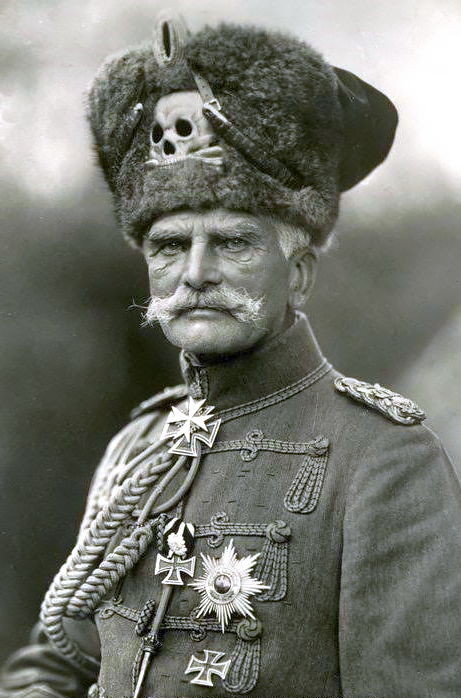
Anton Ludwig Friedrich August von Mackensen, was one of the most a German Generals during World War I (1914–1918) becoming one of the German Empire's most prominent & competent military leaders. He joined the 2nd Leib-Husaren Regiment (Life Hussars, so-called Hussars of the Death), so he wrote to his parents: "I am to my joy so in my black dolman (a jacket decorated with braiding) under the death head...I am not soldier by constraint, but by taste." As his unit wore the distinctive death’s head uniform. During the Franco-Prussian War of 1870–1871, he was promoted to second lieutenant & was awarded the Iron Cross Second Class in battle.
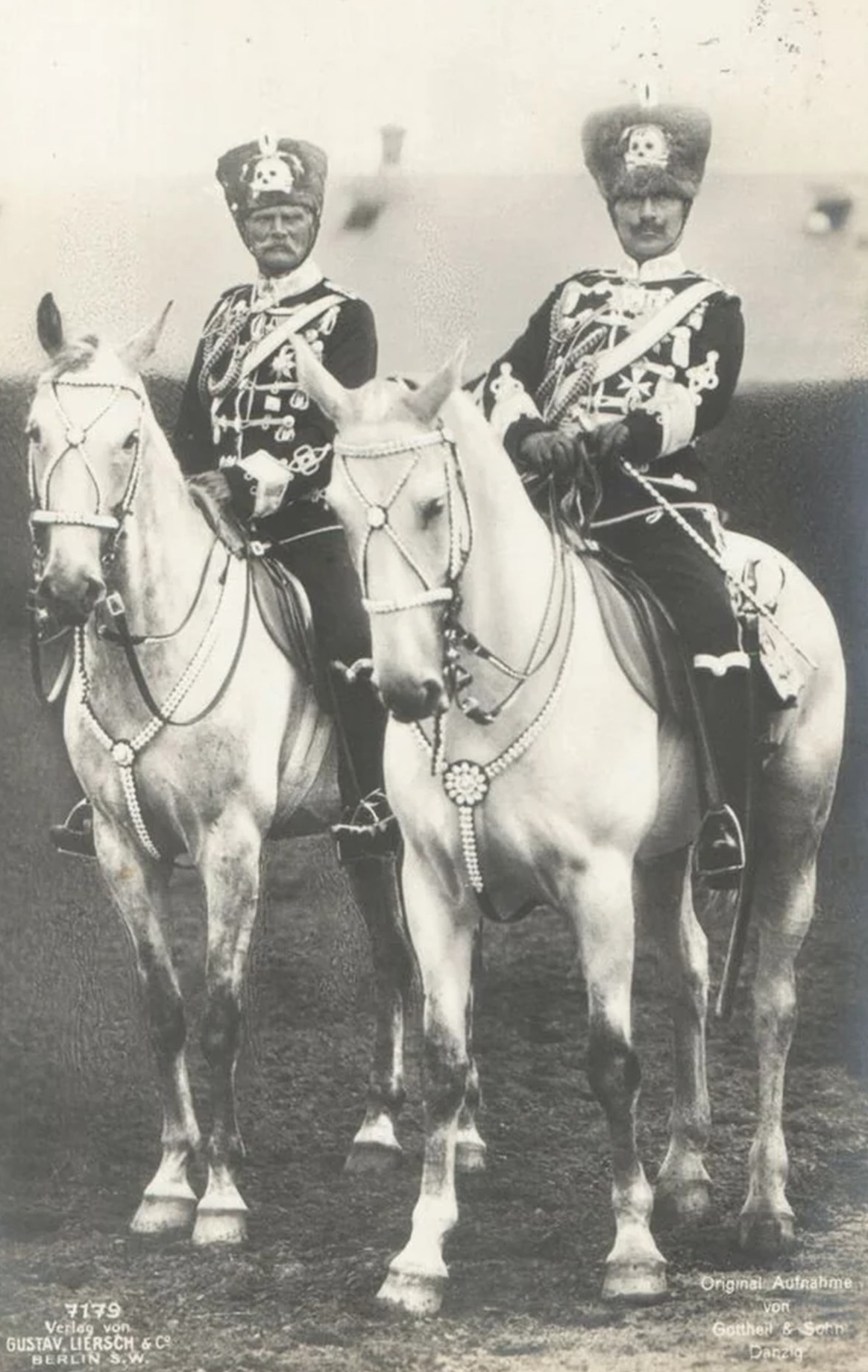
In 1893, after 24 years of service, now a senior Major at 45 years old, Mackensen dons the Totenkopf Busby again when he becomes the commander of his original regiment. The German Emperor is an honorary Colonel of the regiment. In 1901, Mackensen takes command of the Leib Hussars Brigade formed by uniting the lst & 2nd Regiments. He wore the distinctive death’s head uniform thereafter as he became a trusted-advisor of the emperor.
Pre-WWII Death Head Items
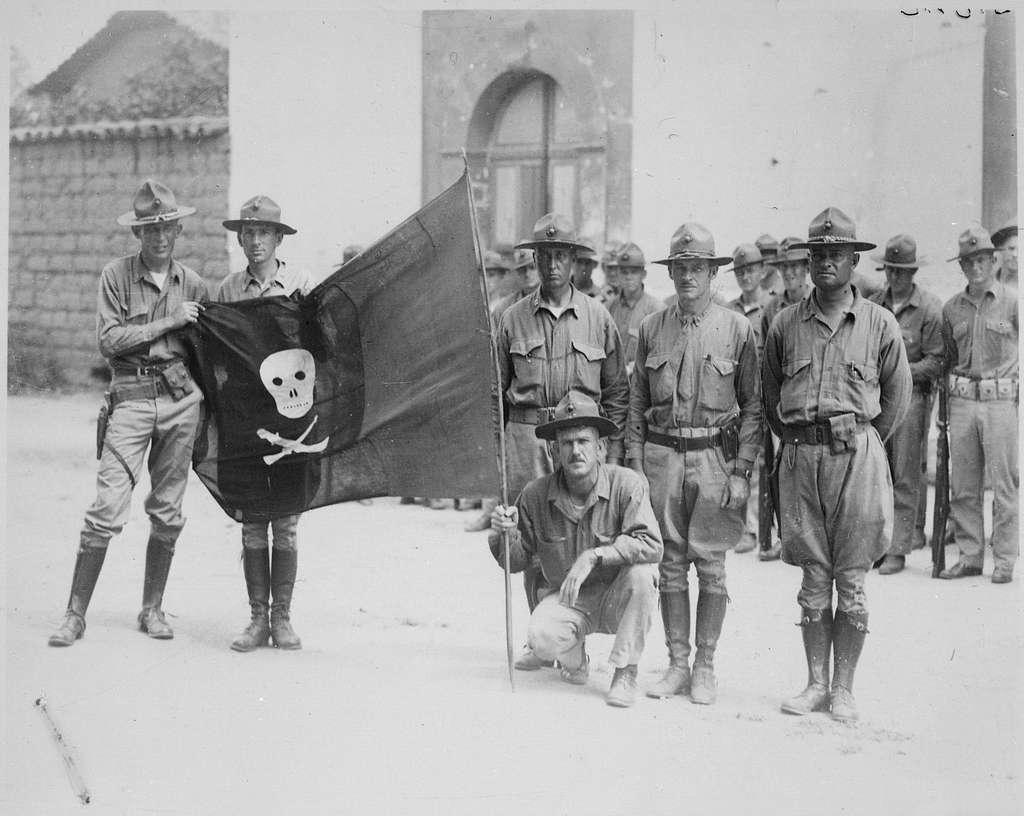
On 16 July 1927, Augusto Sandino's anti-American rebel followers attacked a patrol of U.S. Marines & Nicaraguan Guardia Nacional. A combined force was sent to apprehend Sandino’s “bandits” who were armed primarily with machetes & outdated rifles. They attempted to besiege the Marines & Guardia soldiers at the village of Ocotal, but were easily repulsed with the help of one of history’s first dive-bombing attacks by five USMC de Havilland biplanes. The Marines & Guardia killed 80 of Sandino's men while the Marines suffered two casualties, one dead & one wounded plus three Guardia dead & four taken prisoner.
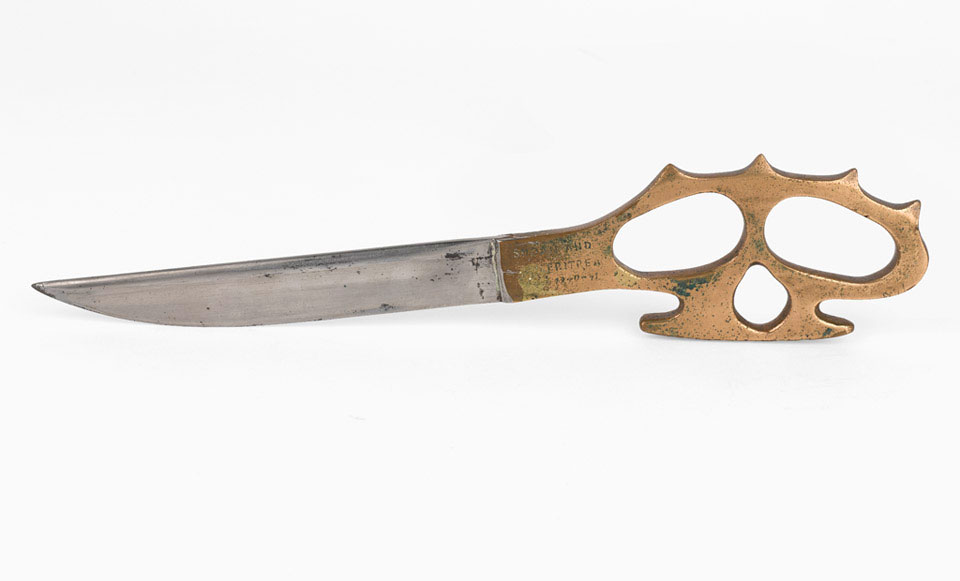
Middle East Royal British Commando knife. Here is an example with a steel blade with cast brass grip with finger rings & protrusions on the exterior of the knuckle grip. The grip is stamped “Lieut. Col. E. J. Kinvig” on one side & “Sudan and Eritrea 1940-41” on the other. These knifes were used by Middle East Commando Forces Numbers 50, 51 & 52 these units participated in most of the British Middle East campaigns during 1940-1942.
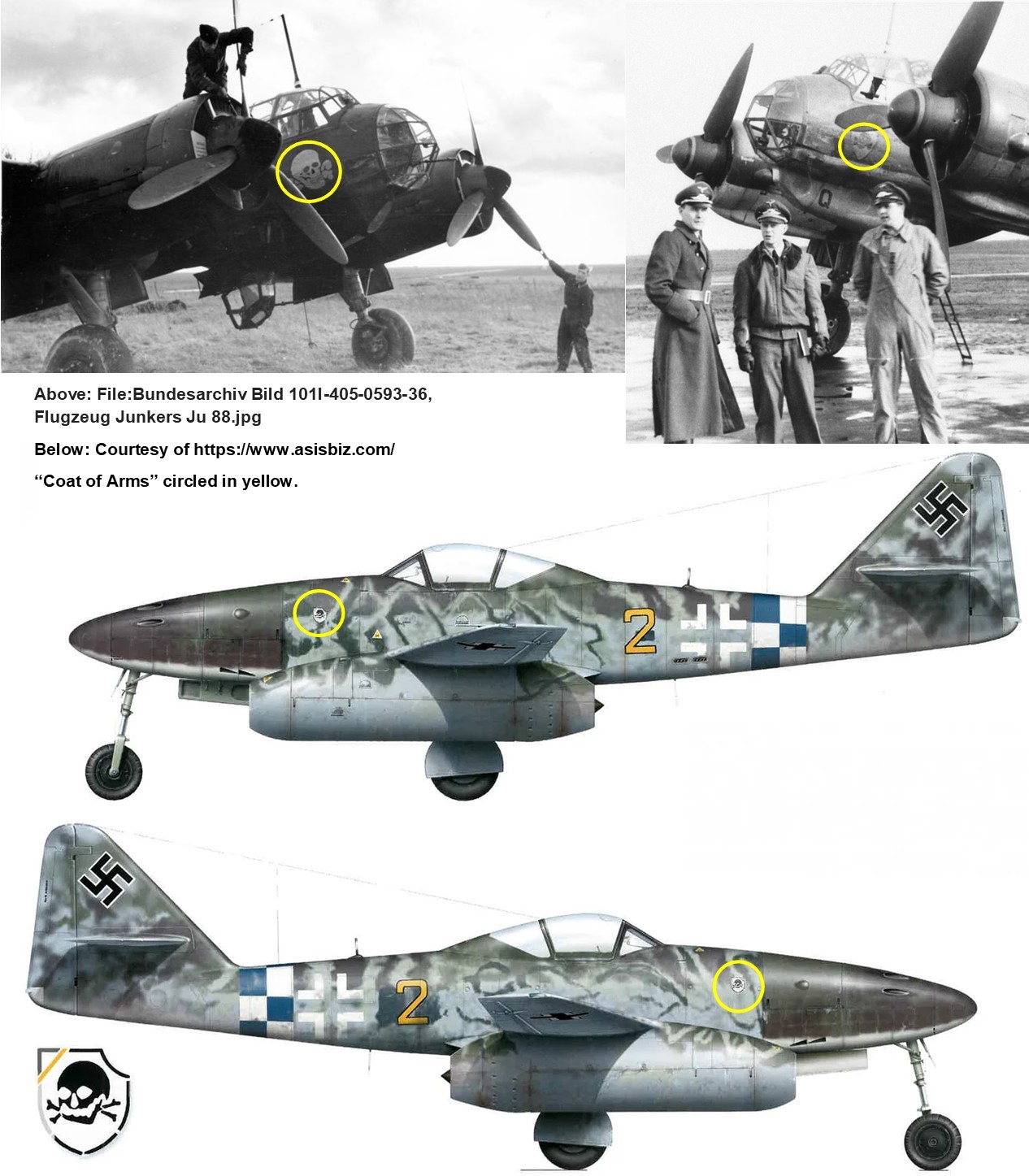
Kampfgeschwader 54 was a squadron of the German Luftwaffe (Air Force) during WWII. Because of its Totenkopf “coat of arms” it was also called the “Skull Squadron.” As a combat squadron for the first four-years it was equipped with Heinkel He 111 & Junkers Ju 88 bombers, carrying out bomb raids during the invasions of Poland & Norway, the Western Campaign, the Battle of Britain, the German-Soviet War, & the Mediterranean area of operations. The squadron did an unusual conversion from bombers to the new Messerschmitt Me 262 jet fighters in October 1944 with a mission to interdict the U.S. 8th Air Force heavy bombers attacking German cities & industrial base.
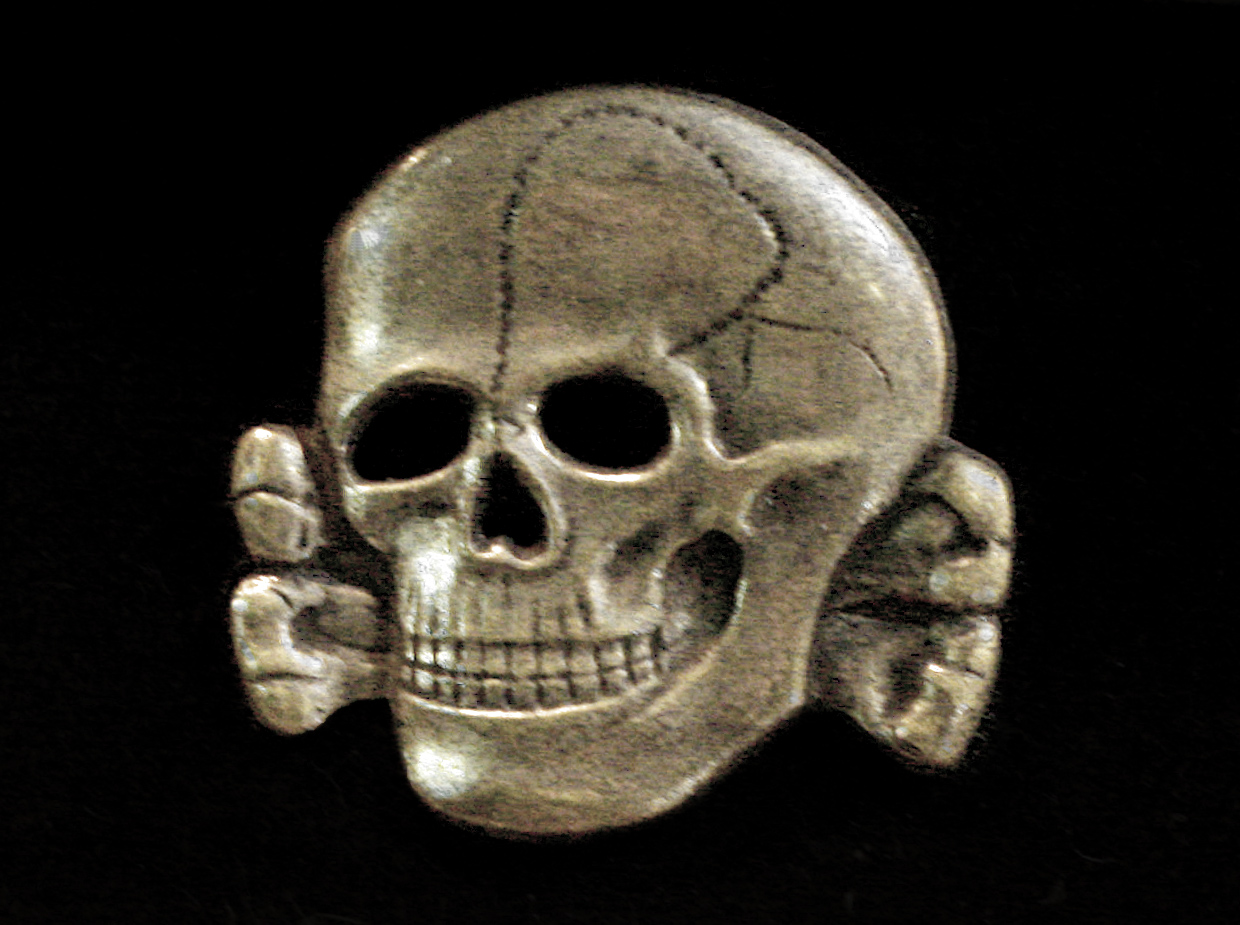
The uniforms and insignia of the Schutzstaffel (SS) served to distinguish its Nazi paramilitary ranks between 1925 and 1945 from the ranks of the Wehrmacht (the German armed forces from 1935), the German state, and the Nazi Party.
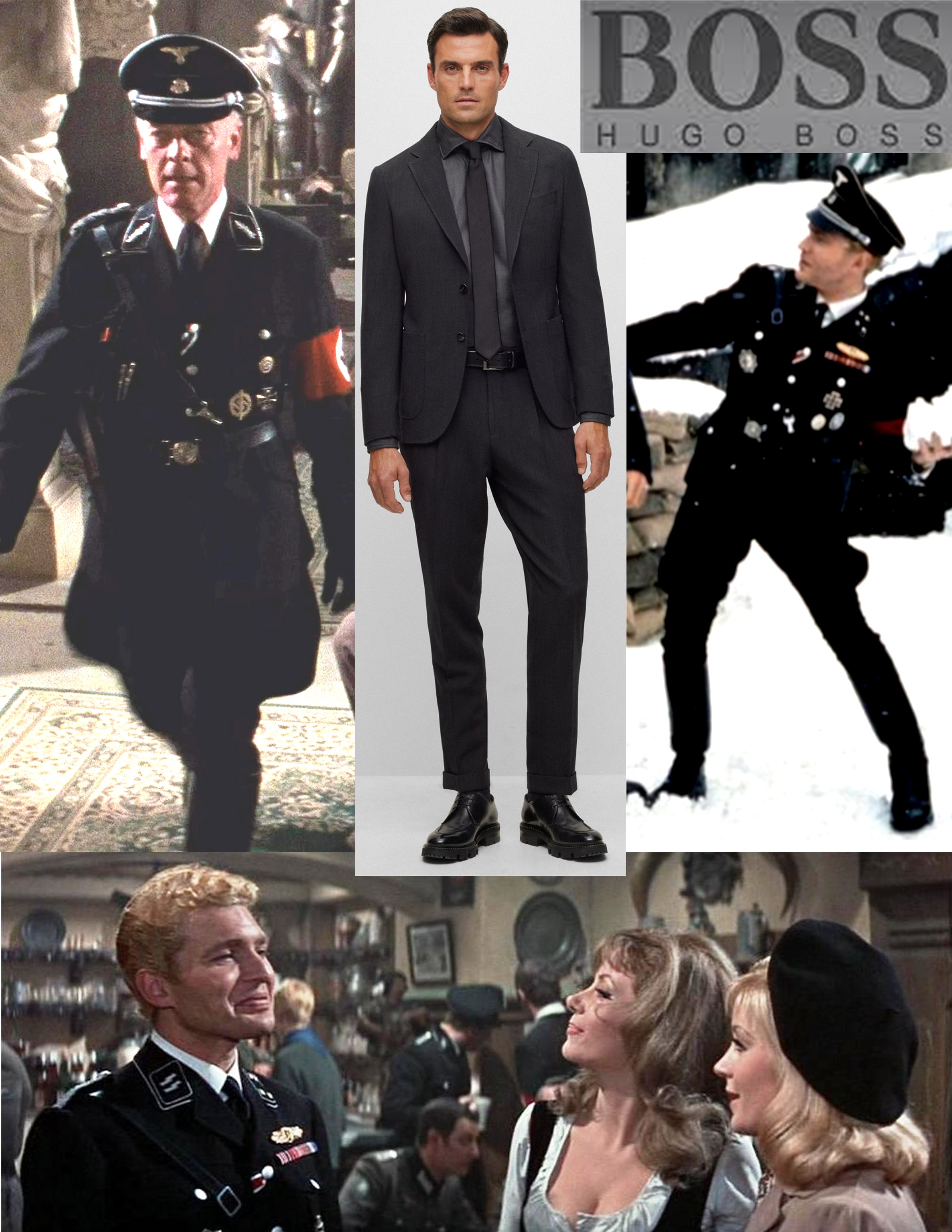
Hugo Boss still one of the great German fashion houses contracted with the Nazi Party in 1928 & in 1932 began to produce the most imposing & now forever evil uniform, the black SS uniforms. While different uniforms existed for the SS over time, the Hugo Boss version is the most well-known as black-white-red color scheme harkened back to German Imperial Empire & later the Nazi Party. Further, black was already popular with fascist groups such as the Italian “blackshirts.” German military tradition also had used black unis & the Totenkopf as the Prussian kings' life-guard cavalry (Leibhusaren) which would extend to the Führer's bodyguard unit. Above The uniforms appeared in both “Where Eagles Dare” SS Sturmbannführer Von Happen (Major) (Derren Nesbitt) & “Indiana Jones and the Last Crusade” SS Standartenführer (Colonel) Vogel (Michael Byrne.)
Here are some of the most famous SS on film (by rows from the top left going left to right):

"Schindler's List" - Camp Commandant SS Untersturmführer Amon Göth (Ralph Fiennes)
"Inglourious Basterds" - SS Standartenführer Hans Landa (Christoph Waltz)
"Patterns of Force"/ Star Trek - Captain of the Starship Enterprise SS Obersturmführer James Kirk (William Shatner) & Science Officer SS Obersturmführer Mister Spock (Leonard Nimoy) in the helmet
"Battle of the Bulge" - SS Standartenführer* Martin Hessler (Robert Shaw) this is such a trainwreck of a movie somehow mid-movie Shaw's character goes from the Wehrmacht (regular army) to the SS!
"Indiana Jones and the Last Crusade" - SS Standartenführer Vogel (Michael Byrne)
"Where Eagles Dare" - SS Sturmbannführer von Hapen (Derren Nesbitt)
"The Great Escape" - SS Untersturmführer Steinach (Karl-Otto Alberty) arrests Stalag (Prison Camp) Luft III Commandant Luftwaffe (Air Force) Oberst (Colonel) Von Luger (Hannes Messemer)
"The Exception" - SS Reichsfuhrer Heinrich Himmler (Eddie Marsan)
"The Eagle Has Landed" - SS Reichsfuhrer Heinrich Himmler (Donald Pleasence)
"Conspiracy" - SS Gruppenführer Reinhard Heydrich (Kenneth Branagh) chaired the January 1942 Wannsee Conference formalizing plans for the "Final Solution" the deportation & genocide of all Jews in German-occupied Europe.
Two of the many 1970 grindhouse sexploitation (Italian/French) films: the first has numerous titles "Fräulein Devil/Elsa Fräulein SS/Fräulein Kitty/Captive Women-4" - with SS Brothel Pleasure Train Madam Elsa Ackermann (Malisa Longo) & the last but not least the ultimate B-movie attention drawing title "Ilsa: She Wolf of the SS" - SS Obersturmbannführer Ilsa (Dyanne Thorne.) Still a shockingly bad film, the mark of a true exploitation classic!
Other WWII Users as many units from many countries here are just a few:
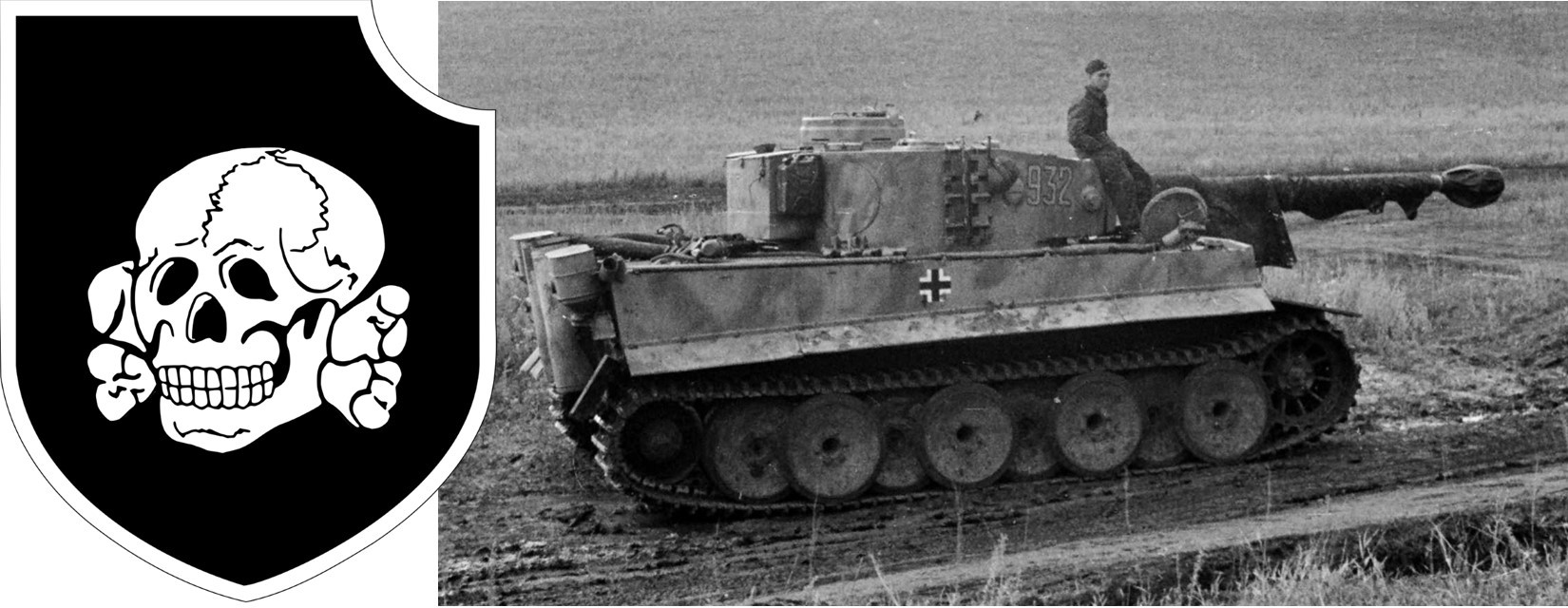
The 3rd SS Panzer Division was named "Totenkopf" & was an elite division of the Waffen-SS during World War II. Using a Totenkopf as its unit symbol it was sometimes referred to as the Death's Head Division. The division became notorious for its brutality, & committed numerous war crimes, including the Le Paradis & Chasselay massacres. The remnants of the division surrendered on 9 May 1945 to U.S. Army forces in Czechoslovakia. Photo: Tiger I coded 932 of the 9th Company, 3rd SS Panzer Regiment, 3rd SS Panzergrenadier Division Totenkopf.

U.S. Marine Corps Raiders emblem represented a special operations “commando” force established during WWII to conduct amphibious light infantry warfare. Merritt A. "Red Mike" Edson commanded the famed 1st Marine Raider Battalion & Major Evans F. Carlson Raiders of 2nd Marine Raider Battalion are said to have been the first United States special operations force modeled on the British Commandos during WWII & was resurrected in 2014 to participate in the Global War on Terrorism.
Other Uses
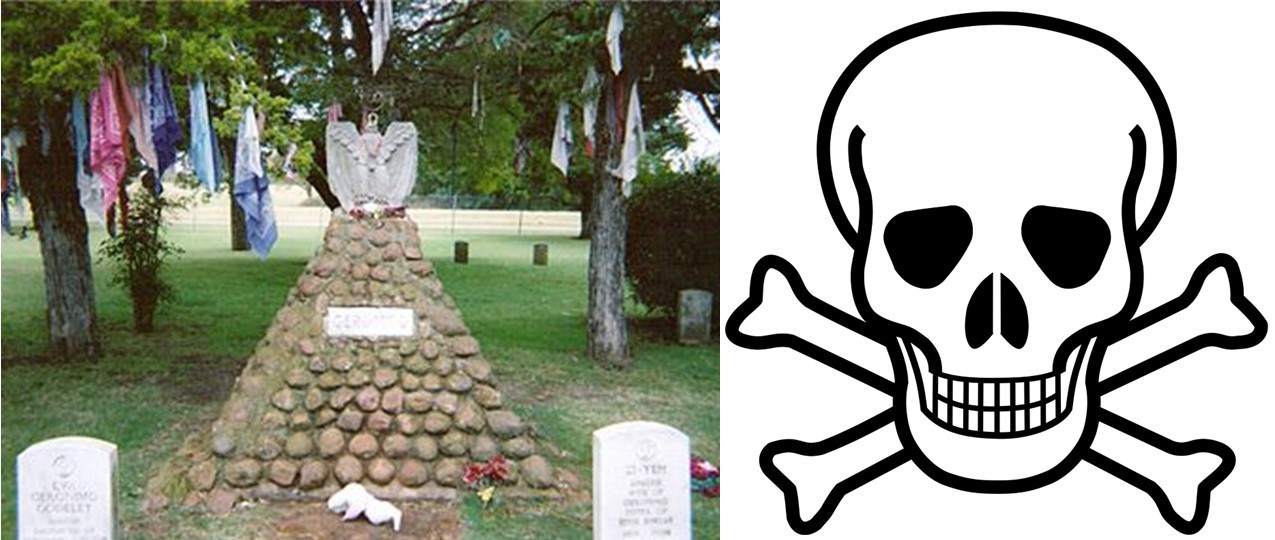
Skull & Bones is a secret society at Yale University that has among its prominent alumni three former presidents, William Howard Taft, George H. W. Bush, & George W. Bush. In the 2004 U.S. Presidential election, both the Democratic & Republican nominees were members of Skull & Bones. When asked what it meant that he and George W. Bush were both “Bonesmen,” Democrat presidential candidate John Kerry said, "Not much, because it's a secret." Bush wrote in his autobiography, "[In my] senior year I joined Skull & Bones, a secret society; so secret, I can't say anything more” Six members of Skull & Bones, including Prescott Bush (father of G.H.W. Bush) served at Fort Sill, OK during WWI & were purported to have taken the skull of Indian Chief Geronimo from its Lawton, OK gravesite to New Haven, CT. The gravesite was later covered by a memorial (pictured above) In recent years, as woke ideology has infected the “Poison” (the skull & crossbones is also a visual warning on something being poisonous) Ivys like Harvard, the society tapped its first entirely non-white class in 2020 & in 2021, bowing to progressive activism pressure, no conservatives were admitted.
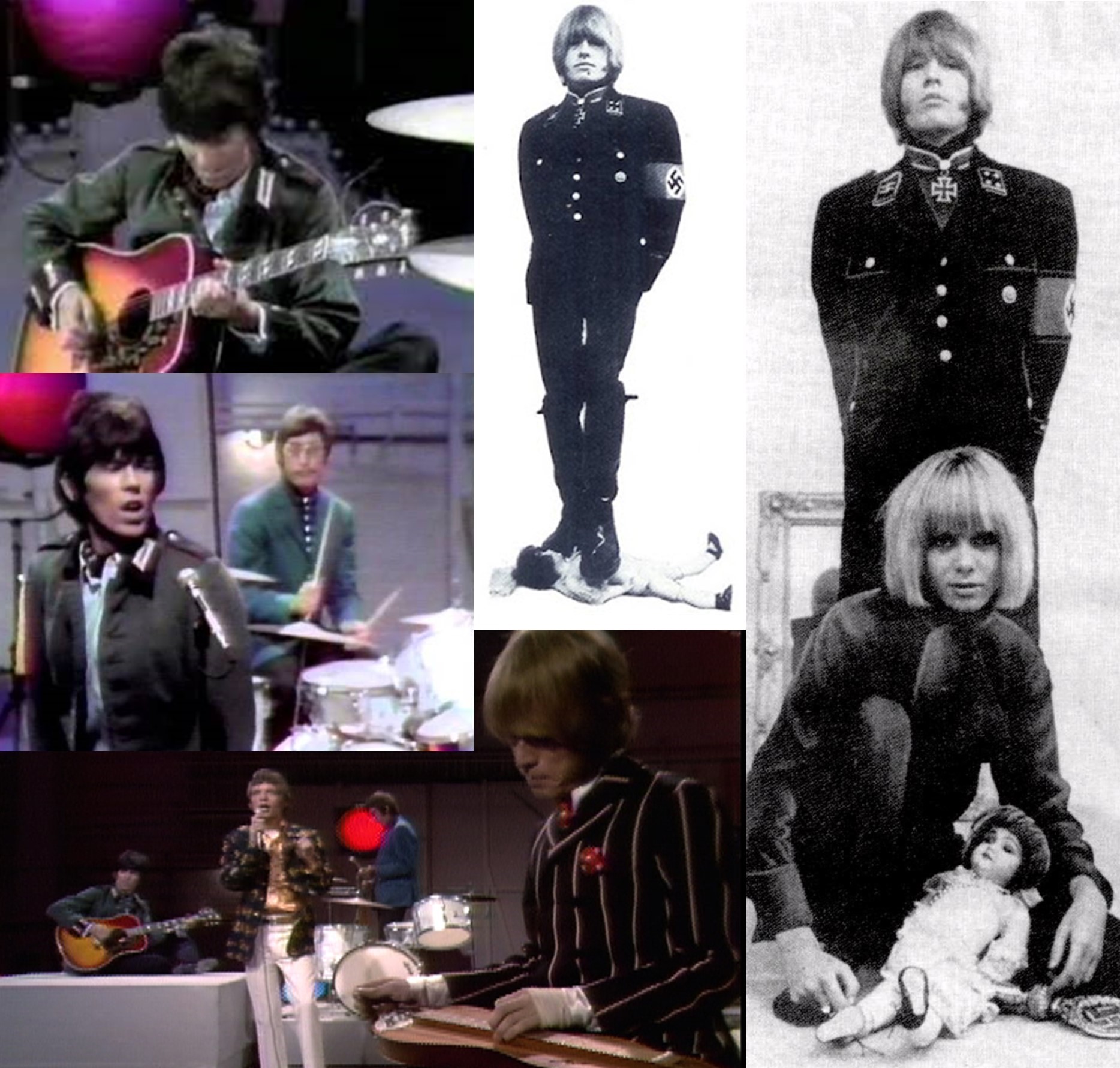
English Rock & Roll musicians from as far back as the 1960s Rolling Stones thru the punk era have used Nazi memorabilia to tweak & rebel against the British Greatest generation. As early as September 11, 1966 Keith Richard of the “Rolling Stones” wore a Wehrmacht Uniform tunic on 'The Ed Sullivan Show' in New York City. Later that year Brian Jones (1942-1969) of the band was persuaded by then-girlfriend, Italian-German actress Anita Pallenberg to don an SS uniform in 1966 for the cover of the Danish magazine Børge to publicize her starring in "A Degree of Murder," a German movie for which Jones did the soundtrack.
Go with MHT this Fall to see the Germany & the Fall of the Third Reich: https://miltours.com/index.php?route=product/product&path=17&product_id=81
Make sure you join us for our next Blog as we explore Googles new history of the Black Nazis!

